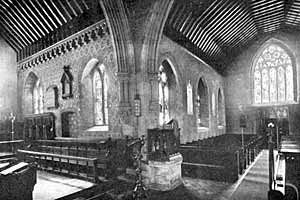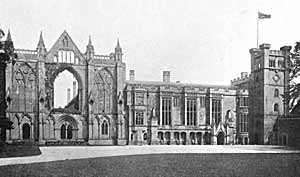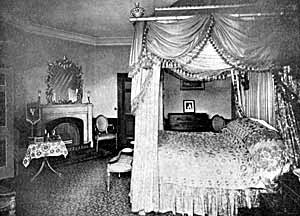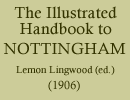< Previous | Contents | Next >
Chapter X.
The suburbs of Nottingham and places of interest to the north.
Bulwell.
THE visitor to Nottingham who takes a car from Trent Bridge to Bulwell can enjoy an uninterrupted ride of four miles—the longest run in the City. After leaving the Market Place the route is past the Roman Catholic Cathedral to an open space into which several roads open, the entrance to the General Cemetery being on the right hand. The road to the left is the high road to Derby (sixteen miles), the next leads to Ilkeston (eight miles), and the one along which the tram proceeds, to Alfreton (sixteen miles). We first pass through the suburb of Radford, chiefly an artizan district, turning to the right at the Council Schools, while the Alfreton Road keeps straight on. Here the tramway for Lenton branches off. The next suburb is Hyson Green, through which we follow the Radford Road, crossing the Gregory Boulevard, on to Old Basford, where there is an ancient church (1126) dedicated to St. Leodegarius, having a "Leper Window" in the chancel.
For Bulwell Forest we leave the car near the tram-sheds, and take a road on the right. The Forest consists of a piece of sandy, undulating land, about a mile long and a quarter of a mile wide, more like a common than a forest, although, doubtless, it is an unenclosed portion of ancient Sherwood. The chief attraction is Golf, where large numbers of people enjoy the exhilarating pastime. The Bulwell Forest Golf Club meets here, also the Artizans', St. Andrew's Institute, etc. The Great Northern and Great Central Stations are on the course, and the Midland close to. The ground is public property, under the management of the Nottingham Corporation, who have built an excellent new club house. Annual subscription £1 11s. 6d., or 1s. per day. The course shows signs of wear, owing to the great amount of play over it, especially by beginners. It is rather narrow, with gorse as the chief hazard, but excellent from a sporting aspect, with a great variety of holes and good greens. No Sunday play allowed.
Hollinwell Golf Links, the meeting-place of the Notts. Golf Club, are reached by Great Central train from Victoria Station, there being a stopping-place for the course, about ten miles north of Nottingham, for the use of members only, and within three hundred yards of the club house. It is an 18-hole course, over 6000 yards long, situated on 240 acres of sandy land leased from the Ecclesiastical Commissioners, commanding beautiful views of Newstead Abbey and Lake (see p. 120). The road to Mansfield, via Hucknall, Annesley Park and the Robin Hood Hills (see Cycling Route, No. vii.), passes near the west side of the course, and the "silvery Leen," which wends its way beneath Nottingham Castle to join the Trent, rises on the course. The sandy character of the soil renders play possible at all times of the year, while hilly formation renders it tiring for all but the young and robust. There are 320 members. Entrance fee, £10 10s. 0d. Annual subscription, £5 5s. 0d. No Sunday play allowed.
Hucknall Torkard.

Burial place of Byron, Hucknall Torkard church.
(Six miles from Nottingham, about 21/2miles from the tram terminus at Bulwell). A favourite place of pilgrimage, because of the Poet Byron's burial in the Parish Church, where his body was laid on July 16th, 1824. The vault contains the remains of many of the poet's ancestors, including his mother, and also his daughter, Ada Augusta. The marble slab in the chancel floor was sent by the King of Greece in acknowledgment of Byron's efforts for the liberation of that country. The church itself is interesting, the lower part of the tower being Norman, some of the windows Decorated, while the south aisle was built in the Perpendicular style in 1872. Hucknall Torkard is a large village inhabited by a coal-mining population.
Bestwood.
(four miles) can be visited either from the Hucknall or Mansfield Roads, and if permission be obtained to drive through the park, a round can be made, going one way and back the other. About half a mile beyond Bulwell the road to Bestwood branches off to the right, and shortly afterwards we are in sight of the great furnaces of the Bestwood Iron Company. Another turn to the right takes us into Bestwood Park. Anciently part of Sherwood Forest, Bestwood or Beskwood constituted a Royal hunting park in the days of the Plantaganet and Lancastrian kings. It afterwards passed into the hands of the Earl of Rutland, and subsequently, in 16S3, into those of the Duke of St. Albans, the descend int of whom still holds the office of hereditary Falconer to the King. There has been a residence on the estate for many years, but the present Gothic edifice was completed in 1885. The Prince and Princess of Wales, the present King and Queen, stayed at Bestwood in 1878 on the occasion of the opening of the Castle as an Art Gallery, and the late Duke of Albany in 1881, when the University College was opened. The interior of the house is not ordinarily shown to visitors. It is at present tenanted by Sir Thomas Birkin, Bart.
Newstead Abbey.

Newstead Abbey.

Lord Byron's bedroom at Newstead Abbey.
(Ten miles). This interesting excursion can be made in an afternoon, either by train, or by carriage or cycle along the Mansfield Road, which is the more interesting. Carriages enter by the gates on the Mansfield Road and put up at the stables by the Abbey, but must return the same way. Cycles are not admitted within the gates, and their owners must walk to the Abbey, about a mile. The approach by rail (Midland or Great Northern, Newstead Station), or carriage via Hucknall, is at the opposite side of the park, carriages not allowed within the gates. Tickets to admit parties not exceeding six may be obtained from the hotel at Newstead, or by application to the housekeeper at the Abbey by letter. Note.—Tickets must be obtained beforehand, and are available on Tuesdays and Fridays between 11 a.m. and 4 p.m.
To Newstead by Mansfield Road.
A mile beyond the tram terminus at Sherwood we arrive at Daybrook, where a halt should be made to inspect the fine church of SS. Peter and Paul, erected by Sir Charles Seely in memory of his wife. The large village to the right of Daybrook is Arnold, in the church of which may be seen an "Easter Sepulchre." By this route we pass Bestwood Lodge gates and Sherwood Lodge, the seat of Sir Charles Seely, after which the road ascends to a height of five hundred feet. Near Newstead we pass, on the right, a temperance house of refreshment, the "Hut," and immediately see the main gates on the opposite side, overshadowed by a noble tree, "The Pilgrim Oak." We now walk or drive through an extensive undulating park, and passing the stables (where carriages may be put up), find ourselves in front of the old Abbey, the great lake lying to our right. The Abbey, or more correctly "Priory," was founded in 1170 by King Henry II. for an Augustinian community. At the dissolution of monasteries in 1539, the house and lands were bestowed on Sir John Byron by King Henry VIII., in whose family they remained to the time of the most famous scion of the house, namely, the poet, George Gordon Noel Byron, who wittily apostrophizes the transaction:
"One holy Henry reared the Gothic walls,
And bade the pious inmates rest in peace.
Another Henry the kind gift recalls,
And bids devotion's hallowed echoes cease."*
The visitor to Newstead must bear in mind that the building is a veritable old monastery, converted for the purposes of a modern residence. The grand fragment of the Priory Church, consisting of the west front, in the Early English and Geometrical styles of architecture, is on our left hand as we face the building, while on our right is the tower, of Norman design, erected by Colonel Wildman, who purchased the Abbey from the needy and not over-provident poet in 1818. The cloisters are Norman, and in the Chapter House, now a chapel, we may see the transition from Norman to Early English. The upper storey of the cloisters, with battlemented parapet, is a later addition in the Perpendicular style. Many restorations were made by Colonel Wildman and his successor, Captain Webb, the descendants of the latter being the present owners.
On entering we are at once conscious of a "dim religious light," owing to the low, groined roof of the hall, which is evidently part of the ancient building. The monks' guest chamber, now the servants' hall, is at right angles with the apartment just mentioned. The cloisters occupy the four sides of a square, in the centre of which is an old stone fountain, the principal apartments being grouped around. In the long galleries are placed the library, numerous hunting trophies collected by Captain Webb, china and other articles of vertu. The visitor is shown a number of state bedrooms, in which kings and famous personages have slept. There are a large number of valuable paintings, especially by Vandyke and Sir Peter Lely, some of the finest being in the Great Drawing-room. The State Dining-room, once the monks' refectory, is particularly worthy of note; and the lofty windows, extending almost from floor to ceiling, form a conspicuous feature of the main front seen from outside. The private dining-room, with groined ceiling, used to be the Prior's apartment.
Most interesting of all is Byron's Bedroom, with all the furniture left exactly as he used it, and adjoining is the room occupied by his page. In another room are the table on which some of his early poetry was written, a number of personal articles used by him, and the piece of the tree on which he carved the names "Byron" and "Augusta." As we pass along the ivy-clad cloisters, with the old-time fountain in the centre, we feel as if we were in another world. Opening out of the cloisters is the old Chapter House of the Priory, now fitted up as a chapel, and near it is the newly-restored "Plantagenet Room."
The Gardens are of great extent and variety. They contain the oak planted by Byron in 1798, also a tree planted by Dr. Livingstone, who visited Newstead in 1864. The monument to "Boatswain," Byron's favourite dog, occupies a site in the monks' old burial ground, east of the high altar. The monks' fish-pond can be seen, from which was fished up the brass lectern, now in Southwell Cathedral, a most interesting relic of the past.
Newstead by way of Hucknall, Annesley.
This is a very convenient route, as the visitor can see Hucknall Church and Annesley Park and Hall on the way. Its disadvantage is the five miles of bare uninteresting streets which have to be passed through. We enter Annesley Park about a mile beyond Hucknall Torkard. The Hall cannot be very distinctly seen through the trees, as it lies at some distance to the left. Here lived Mary Chaworth, about whom Byron wrote his well-known poem, The Dream:
"These two, a maiden and a youth, were there
Gazing—the one on all that was beneath
Fair as herself—but the boy gazed on her;
The maid was on the eve of womanhood;
The boy had fewer summers, but his heart
Had far outgrown his years."
Mary Chaworth married, not Lord Byron, but Mr. Musters, of Colwick (see p. 111). Byron was fifteen at the time of his intimacy with Mary, and no doubt these events were deeply impressed on his soul, as the famous poem was not written for many years. Annesley Hall is a quaintly gabled and ivy-covered building. For Newstead we take the turn to the right, half a mile alter leaving the park.
Mapperley.
This is becoming one of the most attractive residential districts of Nottingham, and a walk "on the Mapperley Hills" is a favourite way of spending an afternoon. The district may be reached by turning into the Mapperley Road by St. Andrew's Church (p. 51), or by car from the Market Place. The top of the hill near the tram terminus is four hundred feet above sea level, and affords magnificent views; there are numerous walks on the "Plains," and short rounds can be taken by Arnold or Gedling. The large building in Coppice Road is the Private Hospital for Lunatics, and the still larger one in the neighbouring Wells Road is the City Lunatic Asylum. Passing this institution on the Wells Road we come into touch with another main tram line—that along St. Anne's Well Road. By taking a car at the terminus, we are brought back to the Market Place.
< Previous | Contents | Next >
*There are various references to Newstead in Byron's works. See Elegy on Newstead Abbey; On the Monument of a Newfoundland Dog; On Leaving Newstead; also Don Juan, Canto xiii.
